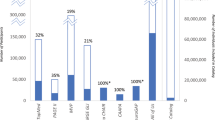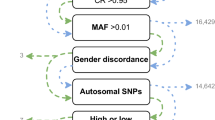Abstract
The Human Genome Project (HGP) represents a massive merging of science and technology in the name of all humanity. While the disease aspects of HGP-generated data have received the greatest publicity and are the strongest rationale for the project, it should be remembered that the HGP has, as its goal the sequencing of all 100,000 human genes and the accurate depiction of the ancestral and functional relationships among these genes. The HGP will thus be constructing the molecular taxonomic norm for humanity. Currently the HGP genomic baseline is almost exclusively skewed toward North Atlantic European lineages through the extensive use of the Centre d’Études du Polymorphisme Humaine (CEPH) data set. More recently, the HGP has shifted to the use of volunteer donors since adequate informed consent had not been secured from the CEPH families. No evidence exists that either the CEPH families or the current volunteers are the most appropriate demographic or evolutionary lineages for the functional genomic studies that will guide production of new DNA based drugs, targeted therapeutics and gene-based diagnostics. The lack of scientific representativeness of the HGP is a serious impediment to its broad applicability. Yet this can be remedied, and five alternative sampling strategies are presented. In response to the current exclusionary design of the HGP, there is noteworthy caution and skepticism in the African American community concerning genetic studies. The Manifesto on Genomic Studies Among African Americans reflects both a desire to be systematically included in federally funded genomic studies and a desire to maintain some control over the interpretation and application of research results. Representative sampling in the HGP is seen as an international human rights issue with domestic ethical implications.
Similar content being viewed by others
References
Lander, E.S. (1996) The new genomics: Global views on biology, Science (25 Oct) 274: 536–539.
Guyer, M.S. & Collins, F.S. (1995) How is the Human Genome Project doing, and what have we learned so far?, Proceedings of the National Academy of Sciences of the United States of America 92: 10841–10848.
Leffers, H., Dejgaard, K., Honore, B., Madsen, P., Nielsen, M.S. & Celis, J.E. (1996) cDNA expression and human two-dimensional gel protein databases: Towards integrating DNA and protein information, Electrophoresis 17(11): 1713–1719.
Baba, Y. (1996) Analysis of disease-causing genes and DNA-based drugs by capillary electrophoresis: Towards DNA diagnosis and gene therapy for human diseases, Journal of Chromatography 687: 271–302.
Dykes, C.W. (1996) Genes, disease and medicine, British Journal of Clinical Pharmacology 42: 683–695.
Cavalli-Sforza, L.L., Menozzi, P. & Piazza, A. (1994) The History and Geography of Human Genes, Princeton University Press: Princeton, NJ.
Chang, K. (1997) UM Professor Questions Diversity of the HGP, Baltimore Sun, Maryland Section, Feb. 22, pp. 1B, 3B.
Wills, C. (1991) Exons, Introns, and Talking Genes: The Science Behind the Human Genome Project, Harper Collins: New York, pp. 277–279.
Phoenix, D.D., Lybrook, S.M., Trottier, R.W., Hodgin, F.C. & Crandall, L.A. (1995) Sickle cell screening policies as portent: How will the Human Genome Project affect public sector genetic services? Journal of the National Medical Association 87: 807–812.
Murray, R. (1996) Clinical perspectives on human genomic testing: Contrasting sickle cell versus Tay-Sachs screening programs in the US. Paper presented, at Health Law Conference, Seton Hall Law School, Newark, NJ, November 4, 1996.
Weiss, K.M. (1996) Is there a paradigm shift in genetics? Lessons from the study of human diseases, Molecular Phylogenetics and Evolution 5(1):259–265
Tsui, L-C. (1992) The spectrum of cystic fibrosis mutations. Trends in Genetics 8: 391–398.
Cystic Fibrosis Genetic Analysis Consortium (CFGAC) (1994) Population variation of common cystic fibrosis mutations, Human Mutation 4: 167–177.
Kittles, R., Perola, M., Peltonen, L., Bergen, A., Aragon, R., Virkkunen, M., Linnoila, M., Goldman, D. & Long, J. (1998) Dual origins of Finns revealed by Y-chromosome haplotype variation, American Journal of Human Genetics 62 (in press).
Peltonen, L., Pekkarinen, P. & Aaltonen, J. (1995) Messages from an isolate: Lessons from the Finnish gene pool, Biological Chemistry Hoppe-Seyler 376: 697–704.
Miklos, G.L.G. & Rubin, G.M. (1996) The role of the genome project in determining gene function: Insights from model organisms, Cell 86: 521–529.
Hernandez, D. & Fisher, E.M.C. (1996) Down syndrome genetics: Unraveling a multifactorial disorder, Human Molecular Genetics 5 (REV. ISSUE): 1411–1416.
Coughlin, S.S., Etheredge, G.D., Metayer, C., Martin, S.A., Jr. (1996) Remember Tuskegee: Public Health student knowledge of the ethical significance of the Tuskegee syphilis study., American Journal of Preventive Medicine 12: 242–246.
Brown, R. & Henderson, J. (1983) The mass production and distribution of HeLa cells at Tuskegee Institute 1953–1959, Journal of the History of Medicine and Allied Sciences 38:415–431.
Cold, M. (1986) A Conspiracy of Cells: One Woman’s Immortal Legacy and the Medical Scandal it Caused, State University of NY Press: Albany.
Karp, L. (1976) The immortality of a cancer victim dead since 1951, Smithsonian Magazine (March), pp. 51–56.
Marks, J. (1995) Human Biodiversity: genes, race, and history, Aldine de Gruyter: New York, NY.
Jackson, F.L.C. (1997a) The taxonomic implications of the HGP, American Journal of Human Biology 9:130.
Jackson, F.L.C. (1997b) Correlation of geographic patterns of ecological diversity and ethnic variation in Africa: Implications for identifying gene X environment interactions and patterns of human genetic heterogeneity, Amer. Journal of Human Biology 9:12.
Relethford, J.H. (1996) Genetic distance can obscure population history: Problem and solution, Human Biology 68:29–44.
Kahn, P. (1994) An African-American diversity project, Science 266: 721.
Mittman, I.S. (1997) Commentary: We must all be equal partners in the new age of genetics, The Scientist (October 13) 11(20): 8.
Munayyer, M.F. (1997) Genetic testing and germ-line manipulation: Constructing a new language for international human rights, American University Journal of International Law and Policy 12: 687–731.
Rollin, B.E. (1996) Ideology, “value-free science”, and animal welfare. Acta Agriculturae Scandinavica Section A Animal Science 0 (SUPPL. 27): 5–10.
Start, R.D., Brown, W., Bryant, R.J., Reed, M.W., Cross, S.S., Kent, G. & Underwood, J.C.E. (1996) Ownership and uses of surgical inpatients?, British Medical Journal 313: 1366–1368.
Clasa, J., Holoman, J., Klepance, J. & Soltes, L. (1996) Ethics committees and achievement of good clinical practice. Therapie (Paris) 51: 369–372.
Gillett, C.R. (1995) Medical ethics in a multicultural context, Journal of Internal Medicine 238: 531–537.
Berg, K., Pettersson, U., Riis, P. & Tranoy, K.E. (1995) Genetics in democratic societies: The Nordic perspective, Clinical Genetics 48: 199–208.
Jackson, F. (1996) Assessing the Human Genome Project: An African American and bioanthropological critique. Paper presented at Tuskegee University Human Genome Conference, September 26, 1996.
Population Reference Bureau (1997) World Population Figures, Mid-Year 1997, PRB: Arlington, VA.
Author information
Authors and Affiliations
Rights and permissions
About this article
Cite this article
Jackson, F. Scientific limitations and ethical ramifications of a non-representative Human Genome Project: African American response. SCI ENG ETHICS 4, 155–170 (1998). https://doi.org/10.1007/s11948-998-0046-6
Received:
Revised:
Accepted:
Issue Date:
DOI: https://doi.org/10.1007/s11948-998-0046-6




